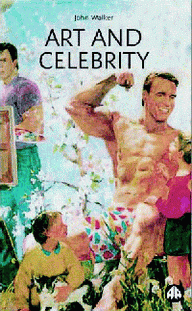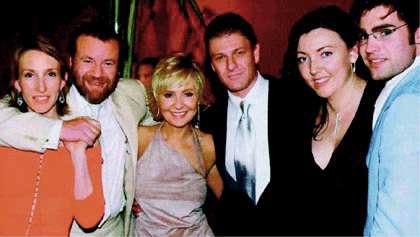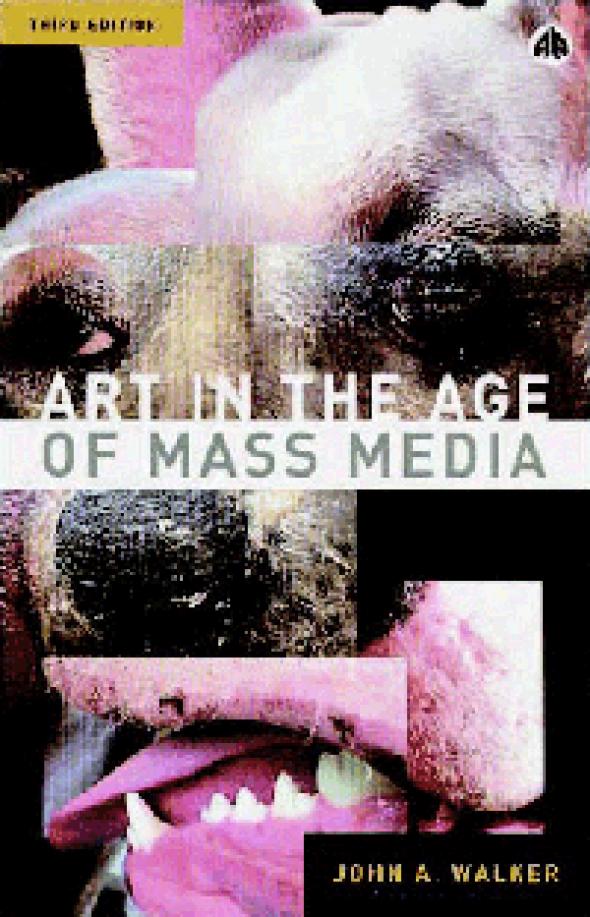2: CELEBRATING CELEBRITY
Art historian John A. Walker has a nose for art’s hot topics. But in his latest title, Art and Celebrity, Dave Beech finds that Walker’s archivist methodology undermines his analysis

John A. Walker is among the shrinking ranks of art’s dissenting academics. Walker has spent the last several decades patrolling the borders of art’s exclusionary regimes. He has not, it should be emphasised, defended art against the threats at its borders; instead, he has explored every gap in the fence for exchange, hybridity and interdependence. Walker was causing trouble at the interstices of art and popular culture (and was one of the first art historians to do so) long before Andreas Huyssen coined the phrase. He identifies himself, straightforwardly, as an art historian. The title is unexpectedly scholastic – too internal to the inherited discipline – for one of the early contributors to what has come to be known as the New Art History and one of the founders of Block magazine.
After writing such books as Art in the Age of Mass Media, Crossovers: Art into Pop, Pop into Art, Art and Artists on Screen and Arts TV: A History of Arts Television in Britain, Walker’s latest title, Art and Celebrity, clearly follows a pattern that he trail blazed before the scholarly fusion of art and popular culture became a full-blown industry. And a received idea. It would be churlish – and shortsighted – to complain about Walker continuing the research project he started so long ago just because it has caught on. What’s more, Art and Celebrity would not be a better book for being published in a culture less acclimatised to its agenda, even if, under such circumstances, it could be more of a publishing event.
‘There is no doubting [celebrity’s] considerable importance in contemporary developed societies,’ Walker announces in the first paragraph of Art and Celebrity. Walker is on to a winner with this title and I can imagine a number of academics and commentators who may, on seeing it, wish that they’d written the book first. Celebrity is as central to late capitalist culture as the concept of virtue was to Aristotle’s Athens. And in that trajectory – from virtue to celebrity – lies the history of civilisation as farce. Celebrity is the endpoint of what used to be called progress before things like industrialised war made a mockery of the idea. Celebrity, as industrialised personality, has become increasingly germane for a cultural and economic system that has shifted from production and commodity exchange to branding and logo awareness. Celebrity is certainly a lens through which we can pay attention to our global predicament. It is also, by its very nature, a robust, if giddy, system that has proved itself to be indifferent and invulnerable to critical reflection. The old clichè ‘there’s no such thing as bad publicity’ is the slogan of celebrity’s resistance to criticism and reflection.
What prevents the critical reflection on celebrity from merely perpetuating the system of iconic exchange that reproduces itself through the act of representation? Given that celebrity converts all representation into its own currency, can a methodological or theoretical campaign overcome celebrity’s aggressive centripetal charm? In other words, if celebrity just wants to be talked about, then how can a critical discourse talk about celebrity without merely adding to its force? This sort of difficulty has not haunted Walker’s projects in the past because he has typically conducted his research by compiling rogue, neglected material in the shape of a coherent cultural object. Art into Pop, Pop into Art, for instance, brings together (for the first time, as far as I’m aware) the leading practitioners of the crossover between art and pop. It is a useful book, packed with examples and information. No argument is developed and no theory is articulated but the book adds up to a kind of case against the aesthetic and cultural isolation of art. The sheer number and variety of actual crossovers means the book seems to do without the re-theorisation of art’s cultural relations undertaken by others.
Art and Celebrity follows the same methodology. It is a compilation of facts, anecdotes, trivia and potted histories. If such a methodology is secretly dependent on exactly the kind of theoretical work from which it shies away, in the case of Art and Celebrity the methodology is truly inappropriate. There is inevitably some value in compiling facts about marginal and dispersed cultural activity. One of the ongoing tasks of cultural transformation is to negate and nullify the values, categories and canons of the cultural settlement. This is done, in part, by flagging up actual, existing alternatives that do not signify for the dominant modes of attention. As such, despite its shortfalls, Walker’s positivist methodology has value when it attends to overlooked areas of culture. When he uses the same methodology to address one of the most dominant forces of late capitalist culture, however, the result is acquiescent and celebratory. Art and Celebrity is governed by the rudimentary principle of assembling records of the coincidences of art and celebrity. This leaves both categories intact. So, instead of calling into question the cultural operations of celebrity by examining its cultural, social and economic structures, Walker tells us ‘the Union Jack flag mini-skirt worn by Geri Halliwell when she was Ginger Spice was sold at a 1998 charity auction in London for £36,200 and is now in the collection of the Hard Rock Hotel, Las Vegas,’ or that ‘revolutionaries sometimes end up as part of the world of entertainment.’
 >> Picture from OK Magazine (left to right): Sam Taylor Wood, Ray Winstone, Lulu, Sean Bean, OK editor Nic McCarthy,and Stuart Manning
>> Picture from OK Magazine (left to right): Sam Taylor Wood, Ray Winstone, Lulu, Sean Bean, OK editor Nic McCarthy,and Stuart Manning
The five sections into which Art and Celebrity is divided – ‘Celebrities as Art Collectors and Artists’, ‘Artists Depict Celebrities’, ‘Simulation and Celebrities’, ‘Alternative Heroes’, and ‘Art Stars’ – are as empirical and ad hoc as the titbits that constitute the book. Art and Celebrity is packed with factoids such as, ‘Koons has dressed in a succession of different outfits and so he did not adopt a uniform comparable to those of Beuys and Gilbert and George’ and ‘Although Picasso had a small, stocky and hairy body, he was a virile heterosexual with a magnetic personality.’ Walker’s style, not unlike Matthew Collings’, is characterised by small chains of seemingly bland statements. For the younger writer, the style is mischievous; for Walker, it is an empiricist’s idea of self-defence – as if tight little units of low-risk statements will shield the text as a whole from error, bad judgement and self-indulgence. Both writers use their style to immunise themselves from theory. If I’m not mistaken, this apparent immunity to theory is not only shared by Collings and Walker, it is typical, also, of celebrity culture. Collings is, in effect, a celebrity writer; Walker merely doesn’t have the theoretical wherewithal to deal with celebrity without unwittingly endorsing it.
Despite relying so heavily on the individual fact, there is no attention to the specificities of celebrity in Walker’s book – as if the celebrity of film stars, rock stars, Renaissance artists and tabloid friendly shocking young things were indistinguishable. Walker includes all of these in his category of the convergence of art and celebrity – and rightly so – but he fails to articulate anything of the way the concept shifts from one context to another. Imagine how Foucault might have traced the uses and effects of celebrity, or how Raymond Williams would have analysed its various social formations and their interconnections and contradictions: this sort of detailed, nuanced examination is essential to critical reflection because it takes a naturalised concept such as celebrity and resituates it in its various historical trajectories and subjects it to the struggles and disputes from which it emerged. This sort of detail is entirely absent from Walker’s Art and Celebrity. Similarly, whenever the need arises to theorise celebrity – as it inevitably does – Walker borrows a line or two from somebody else. It is as if his use of archival material for the facts that fill his book is suitable for the conceptual framework of the book, too. Therefore, while Walker may be critical of celebrity as a social force, he shows no sign whatsoever of being critical of celebrity as a discourse. He accedes to its terms as they have solidified from social use and, consequently, parades the concept of celebrity throughout his book as if there were no alternative.
Art and Celebrity is a strange addition to Walker’s oeuvre, at one and the same time a literal continuation of his signature theme and yet, unexpectedly, out of kilter. Walker has made an important and radical contribution to art history and cultural studies. Several of his books are genuinely essential reading. Despite following the same pattern, Art and Celebrity is not one of them. Like a verbatim translation, or an acolyte’s all-too-faithful homage, Art and Celebrity should work, but doesn’t. It is a timely book insofar as today it goes without saying that the worlds of art and celebrity are completely intertwined. What’s more, the nature of their convergence is in need of investigation, resistance and critical reflection. Art and Celebrity doesn’t even scratch the airbrushed surface of celebrity. Walker hasn’t written the book that we might have hoped for but, as usual, he is pointing in the right direction.
John A Walker // Art and Celebrity // Pluto Press, 2003 // ISBN 0 7453 1849 5 // paperback £14.99
Dave Beech is an artist based in Manchester. He is Subject Leader in Fine Art as Social Practice at the University of Wolverhampton and Co-Director of floating ip gallery, Ancoats. His book The Philistine Controversy, co-edited with John Roberts, was published by Verso last year
Mute Books Orders
For Mute Books distribution contact Anagram Books
contact@anagrambooks.com
For online purchases visit anagrambooks.com








